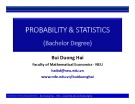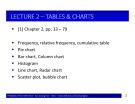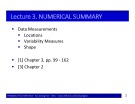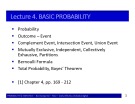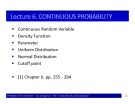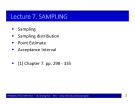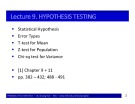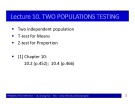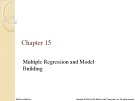Lecture 8. ESTIMATION Lecture 8. ESTIMATION
[1] Chapter 8, Chapter 11
PROBABILITY & STATISTICS – Bui Duong Hai – NEU – www.mfe.edu.vn/buiduonghai
1
Concept of Estimate Point Estimate Maximum Likelihood Estimate Interval Estimate For Mean For Proportion For Variance (pp. 484 – 488)
8.1. Concept of Estimate 8.1. Concept of Estimate
Estimation is determining the approximate value of a
unknown parameter on given data.
Two types of estimate: Point estimate: single value Interval estimate: an interval that parameter falls into
it with a determined probability level
PROBABILITY & STATISTICS – Bui Duong Hai – NEU – www.mfe.edu.vn/buiduonghai
2
Ex. “The average height of VN’s male is 163 cm” “The average height of VN’s male is from 160 to 165 cm”
8.2. Point Estimate 8.2. Point Estimate
Point estimate of parameter � is denoted by �� Estimator: a statistic calculated on random sample, an approximation to unknown parameter. Estimator is a random variable
Estimate: specific value calculated on observed
sample. Estimate is number.
Ex. Formula �̅ = is an estimator
∑�� �
�����
Value �̅ = = 5 is an estimate
�
PROBABILITY & STATISTICS – Bui Duong Hai – NEU – www.mfe.edu.vn/buiduonghai
3
Point Estimate Point Estimate
Population parameters �,��,� are unknown Estimate by statistics from sample
PROBABILITY & STATISTICS – Bui Duong Hai – NEU – www.mfe.edu.vn/buiduonghai
4
Sample mean �̅ is point estimate for � Sample variance �� is point estimate for �� Sample proportion �̅ is point estimate for �
Properties of Point Estimate Properties of Point Estimate
Estimate for � by �� Unbiased: �� is unbiased estimator of �
� �� = � Efficient: ��� and ��� are unbiased, ��� is more efficient
than ��� :
� ��� < � ��� If � ��� is smallest in every unbiased estimator: most
efficient, best estimator
PROBABILITY & STATISTICS – Bui Duong Hai – NEU – www.mfe.edu.vn/buiduonghai
5
BUE (Best Unbiased Estimator)
Example Example
Example.8.1. Population mean �, sample (��,��,… ,��) (a) Which of the followings are unbiased estimator? (b) Which of the unbiased estimator is more efficient?
�
�
�
�
� � = �� + �� � � = �� + ��
�
�
�
�
�
�
�
�
�
� � = �� + �� � � = �� + �� + ��
�
�
�
�
�
�
�
�
� � = ���� + ���� � � = �� + �� + ⋯ + ��
�
�
�
PROBABILITY & STATISTICS – Bui Duong Hai – NEU – www.mfe.edu.vn/buiduonghai
6
Example Example
Example.8.2. Population mean of �, there are two sample. The first sample has size of 4, and mean of �̅�; the second sample has size of 8 and sample mean �̅�. Which are the unbiased estimator, and which is more efficient in the followings:
�
�
�
�
�� = �̅� + �̅� �� = �̅� + �̅�
�
�
�
�
�
�
�
�
�� = �̅� + �̅� �� = �̅� + �̅�
�
�
�
�
PROBABILITY & STATISTICS – Bui Duong Hai – NEU – www.mfe.edu.vn/buiduonghai
7
8.3. Maximum Likelihood (ML) Estimate 8.3. Maximum Likelihood (ML) Estimate
Ex. Probability that a student pass an exam is � = 0.6. Which of the following sample is most likely to occurs �� = (����,����,����) �� = (����,����,����) �� = (����,����,����) �� = (����,����,����)
PROBABILITY & STATISTICS – Bui Duong Hai – NEU – www.mfe.edu.vn/buiduonghai
8
Likelihood function is Probability � �� = 0.6 ∗ 0.4 ∗ 0.4 = � �� = 0.4 ∗ 0.6 ∗ 0.4 = � �� = 0.4 ∗ 0.4 ∗ 0.4 = � �� = 0.6 ∗ 0.6 ∗ 0.6 =
Maximum Likelihood (ML) Estimate Maximum Likelihood (ML) Estimate
Ex. The sample is: � = (����,����,����,����) Which of the following value of � is most likely?
� = 0.2; � = 0.4; � = 0.6; � = 0.8
PROBABILITY & STATISTICS – Bui Duong Hai – NEU – www.mfe.edu.vn/buiduonghai
9
Likelihood function � = 0.2 � � = 0.2 ∗ 0.8 ∗ 0.2 ∗ 0.2 = � = 0.4 � � = 0.4 ∗ 0.6 ∗ 0.4 ∗ 0.4 = � = 0.6 � � = 0.6 ∗ 0.4 ∗ 0.6 ∗ 0.6 = � = 0.8 � � = 0.8 ∗ 0.2 ∗ 0.8 ∗ 0.8 = Find the maximum likelihood estimate?
8.4. Interval Estimate for Mean 8.4. Interval Estimate for Mean
The interval (��,��)is interval estimate of �, then
�(�� < � < ��) is equal to (1 − �)
(��,��)is confidence interval (1 − �)is confidence level � = �� − �� is the width of confidence interval ��: Lower Limit (LL) ��: Upper Limit (UL) The shorter (narrower) the � is, the more accurate
PROBABILITY & STATISTICS – Bui Duong Hai – NEU – www.mfe.edu.vn/buiduonghai
10
the estimate is.
Confidence Interval for Mean � Confidence Interval for Mean �
< � < �� − �(���)�/� �� − �(���)�/�
Population is unknown, estimate for the mean � Sample size �, mean of �̅, variance of �� Confidence level (1 − �), confidence interval � � � �
�
or �� ± �(���)�/�
�
PROBABILITY & STATISTICS – Bui Duong Hai – NEU – www.mfe.edu.vn/buiduonghai
11
Value � �� in the Table 2 (p. 976); � ��� �� ≈ �
Confidence Interval for � Confidence Interval for �
�
Marignal Error �� = �(���)�/�
�
Confidence interval: �� ± ��
�
PROBABILITY & STATISTICS – Bui Duong Hai – NEU – www.mfe.edu.vn/buiduonghai
12
� = ��/� Narrower the Confidence Interval Reduce standard deviation � Reduce confidence level Increase sample size � � ��
Example Example
Example 8.3. From the normality population, collect two samples Sample 1: 15, 17, 16, 20, 17 Sample 2: 18, 13, 14, 20, 15, 13
PROBABILITY & STATISTICS – Bui Duong Hai – NEU – www.mfe.edu.vn/buiduonghai
13
With confidence level of 95%, find confidence interval of mean by using data in Sample 1, Sample 2, and Pooled sample
Example Example
Example 8.3 (cont.) Sample 1:
��������������
= �̅� =
???
=
����̅ �� ����̅ �� ����̅ �� ����̅ �� ����̅ � ???
� = �� � = 5; 1 − � = 0.95
� = 8.3
� = 6.164
PROBABILITY & STATISTICS – Bui Duong Hai – NEU – www.mfe.edu.vn/buiduonghai
14
Sample 2: �̅� = 15.5 �� Pooled sample: �̅� = 16.182 ��
Example Example
Example 8.4. To estimate the average score of students in Maths, 40 students’ score are collected, and the sample mean is 74.5, and sample variance is 64. Assumed that score is normal distributed (a) Find the 95% confidence interval of average score (b) Find the 90% confidence interval of average score (c) To reduce interval width to less than 4:
PROBABILITY & STATISTICS – Bui Duong Hai – NEU – www.mfe.edu.vn/buiduonghai
15
(c1) With level 95%, how many observations should be surveyed (c2) With above sample, how much confidence level should be
8.5. Interval Estimate for Proportion 8.5. Interval Estimate for Proportion
Population proportion � is unknown Sample has size of �, sample proportion �̅ Confidence interval level (1 − �)
�� − ��/� < � < �� + ��/�
��(� − ��) � ��(� − ��) �
��(����)
Or �� ± �� with �� = ��/�
�
� ��(����) ��/� ���
PROBABILITY & STATISTICS – Bui Duong Hai – NEU – www.mfe.edu.vn/buiduonghai
16
Sample size: � =
Example Example
Example 8.5. In 200 observed visitors, 50 of them buying goods, and 40 using services. With confidence level of 95% (a) Estimate of buyer proportion in the visitors (b) To have interval that narrower than 10%, how many
observations should be surveyed?
(c) Estimate the proportion of visitors who do not use
services
PROBABILITY & STATISTICS – Bui Duong Hai – NEU – www.mfe.edu.vn/buiduonghai
17
(d) In 4000 visitors, estimate the total number of buyers
8.6. Interval Estimate for Variance 8.6. Interval Estimate for Variance
< �� <
�
Population variance �� is unknown Sample has size of �, sample proportion �� Confidence interval level (1 − �) ��(� − �) � ��� �/� ��(� − �) � � ��� ���/�
PROBABILITY & STATISTICS – Bui Duong Hai – NEU – www.mfe.edu.vn/buiduonghai
18
Example 8.6. To estimate the variability of the time spent on producing, manager random observed 40 times and calculated the variance was 12.5 minutes2. Find the 95% interval estimate of the producing time’s variance, assumed that time is normal distributed.
Key Concepts Key Concepts
PROBABILITY & STATISTICS – Bui Duong Hai – NEU – www.mfe.edu.vn/buiduonghai
19
Point Estimate Unbiased, Efficient Estimator Confidence Interval Confidence Level, Marginal Error Confidence Interval for Mean Confidence Interval for Proportion Confidence Interval for Sample
Exercise Exercise
PROBABILITY & STATISTICS – Bui Duong Hai – NEU – www.mfe.edu.vn/buiduonghai
20
[1] Chapter 8 (349) 2, 6, 8, 10 (357) 13, 14, 17, 18, 21, (261) 26, 30 (366) 32, 34, 36, 38, 40 Case Problem 1, 3

